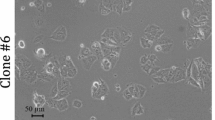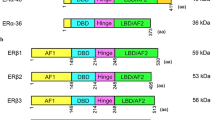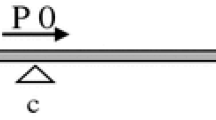Summary
We have used in vitro DNA binding assays as a measure of estrogen receptor (ER) function in human breast tumors. We found that the majority of ER+ (25 ER+/progesterone receptor [PgR]+, and 25 ER+/PgR−) tumors we examined were capable of binding consensus estrogen response element (ERE) oligonucleotides in this assay system. We found significant proteolytic activity in many of the tumors such that protease inhibitors were found to be essential during the preparation of tumor extracts. We next applied direct sequence analysis of the ER DNA binding domain of several of these tumors, and determined that the ER+/PgR− breast tumors did not contain mutations within the DNA binding domain which might explain their apparent discordant receptor phenotype. We did identify an alternatively spliced ER variant missing exon 3 of the DNA binding domain. This variant was unable to function as a transcriptional inducer of an estrogen-responsive reporter in a yeast assay system. Furthermore, the exon 3 ER deletion variant was expressed at equivalent levels in all of the ER+ breast tumors, so that it does not appear to be involved in the evolution of the ER+/PgR− breast cancer phenotype.
Similar content being viewed by others
References
McGuire WL, Clark GM: Prognostic factors and treatment decisions in axillary node-negative breast cancer. N Engl J Med 326:1756–1761, 1992
McGuire WL: Hormone receptors: Their role in predicting prognosis and response to endocrine therapy. Semin Oncol 5:428–433, 1978
Clark GM, McGuire WL: Steroid receptors and other prognostic factors in primary breast cancer. Semin Oncol 15:20–25, 1988
Osborne CK, Yochmowitz MG, Knight WA III, McGuire WL: The value of estrogen and progesterone receptors in the treatment of breast cancer. Cancer 46:2884–2888, 1980
Dickson RB, Lippman ME: Estrogenic regulation of growth and polypeptide growth factor secretion in human breast carcinoma. Endocr Rev 8:29–43, 1987
Osborne CK, Coronado E, Allred DC, Wiebe V, DeGregorio M: Acquired tamoxifen resistance: Correlation with reduced breast tumor levels of tamoxifen and isomerization of trans-4-hydroxytamoxifen. J Natl Cancer Inst 83:1477–1482, 1991
Fuqua SAW, Fitzgerald SD, Chamness GC, Tandon AK, McDonnell DP, Nawaz Z, O'Malley BW, McGuire WL: Variant human breast tumor estrogen receptor with constitutive transcriptional activity. Cancer Res 51:105–109, 1991
Fuqua SAW, Fitzgerald SD, Allred DC, Elledge RM, Nawaz Z, McDonnell DP, O'Malley BW, Greene GL, McGuire WL: Inhibition of estrogen receptor action by a naturally occurring variant in human breast tumors. Cancer Res 52:483–486, 1992
Foster BD, Cavener DR, Parl FF: Binding analysis of the estrogen receptor to its specific DNA target site in human breast cancer. Cancer Res 51:3405–3410, 1991
Scott GK, Kushner P, Vigne J-L, Benz CC: Truncated forms of DNA-binding estrogen receptors in human breast cancer. J Clin Invest 88:700–706, 1991
Kumar V, Chambon P: The estrogen receptor binds tightly to its responsive element as a ligand-induced homodimer. Cell 55:145–156, 1988
Marcelli M, Zoppi S, Grino PB, Griffin JE, Wilson JD, McPaul MJ: A mutation in the DNA-binding domain of the androgen receptor gene causes complete testicular feminization in a patient with receptor-positive androgen resistance. J Clin Invest 87:1123–1126, 1991
Quigley CA, Evans BAJ, Simental JA, Marschke KB, Sar M, Lubahn DB, Davies P, Hughes IA, Wilson EM, French FS: Complete androgen insensitivity due to deletion of exon C of the androgen receptor gene highlights the functional importance of the second zinc finger of the androgen receptor in vivo. Molec Endocrinol 6:1103–1112, 1992
Sone T, Marx SJ, Liberman UA, Pike JW: A unique point mutation in the human vitamin D receptor chromosomal gene confers hereditary resistance to 1,25-dihydroxyvitamin D3. Molec Endocrinol 4:623–631, 1990
Elias JM, Margiotta M, Gabore D: Sensitivity and detection efficiency of the peroxidase-antiperoxidase (PAT), avidin-biotin peroxidase complex (ABC), and peroxidase-labeled avidin-biotin (LAB) methods. Am J Clin Pathol 92:62–67, 1989
Greene GL, Sobel BN, King WJ, Jensen EV: Immunochemical studies of estrogen receptors. J Steroid Biochem 20:51–56, 1984
Greene GL, Harris K, Bova R, Kinders R, Moore B, Nolan C: Purification of T47D human progesterone receptor and immunohistochemical characterization with monoclonal antibodies. Molec Endocrinol 2:714–726, 1988
Brown AMC, Jeltsch J-M, Roberts M, Chambon P: Activation of pS2 gene transcription is a primary response to estrogen in the human breast cancer cell line MCF-7. Proc Natl Acad Sci USA 81:6344–6348, 1984
Wang L-H, Tsai SY, Cook RG, Beattie WG, Tsai M-J, O'Malley BW: COUP transcription factor is a member of the steroid receptor superfamily. Nature 340:163–166, 1989
Greene GL, Gilna P, Waterfield M, Baker A, Hort Y, Shine J: Sequence and expression of human estrogen receptor complementary DNA. Science 23:1150–1154, 1986
Sanger F, Nicklen S, Coulson AR: DNA sequencing with chain-terminating inhibitors. Proc Natl Acad Sci USA 74:5463–5467, 1977
Pham TA, Hwung Y-P, Santiso-Mere D, McDonnell DP, O'Malley BW: Ligand-dependent and -independent function of the transactivation regions of the human estrogen receptor in yeast. Molec Endocrinol 6:1043–1050, 1992
McDonnell DP, Nawaz Z, O'Malley BW: In situ distinction between steroid receptor binding and transactivation at a target gene. Molec Cell Biol 11:4350–4355, 1991
Rio MC, Bellocq JP, Gairard B, Rasmussen UB, Krust A, Koehl C, Calderoli H, Schiff V, Renaud R, Chambon P: Specific expression of the pS2 gene in subclasses of breast cancers in comparison with expression of the estrogen and progesterone receptors and the oncogene ERBB2. Proc Natl Acad Sci USA 84:9243–9247, 1987
Danzo BJ: A protease acting on the estrogen receptor may modify its action in the adult rabbit epididymis. J Steroid Biochem 25:511–519, 1986
Horigome T, Ogata F, Golding S, Korach KS: Estradiol-stimulated proteolytic cleavage of the estrogen receptor. Endocrinol 123:2540–2548, 1988
Graham ML II, Krett NL, Miller LA, Leslie KK, Gordon DF, Wood WM, Wei LL, Horwitz KB: T47DCO cells, genetically unstable and containing estrogen receptor mutations, are a model for the progression of breast cancers to hormone resistance. Cancer Res 50:6208–6217, 1990
Kumar V, Green S, Stack G, Berry M, Jin J-R, Chambon P: Functional domains of the human estrogen receptor. Cell 51:941–951, 1987
Ponglikitmongkol M, Green S, Chambon P: Genomic organization of the human oestrogen receptor gene. EMBO J 7:3385–3388, 1988
McGuire WL: Estrogen receptor variants in clinical breast cancer [Abstract]. Endocrine Society 26, 1991
McGuire WL, Chamness GC, Fuqua SAW: Estrogen receptor variants in clinical breast cancer. Molec Endocrinol 5:1571–1577, 1991
Wang Y, Miksicek RJ: Identification of a dominantnegative form of the estrogen receptor. Molec Endocrinol 5:1707–1715, 1991
Author information
Authors and Affiliations
Additional information
William L. McGuire was a Clinical Professor of the American Cancer Society until his untimely death on March 25, 1992, while this work was in progress. This report is dedicated to his memory, with gratitude for his leadership and his support.
Rights and permissions
About this article
Cite this article
Fuqua, S.A.W., Allred, D.C., Elledge, R.M. et al. The ER-positive / PgR-negative breast cancer phenotype is not associated with mutations within the DNA binding domain. Breast Cancer Res Tr 26, 191–202 (1993). https://doi.org/10.1007/BF00689692
Issue Date:
DOI: https://doi.org/10.1007/BF00689692




